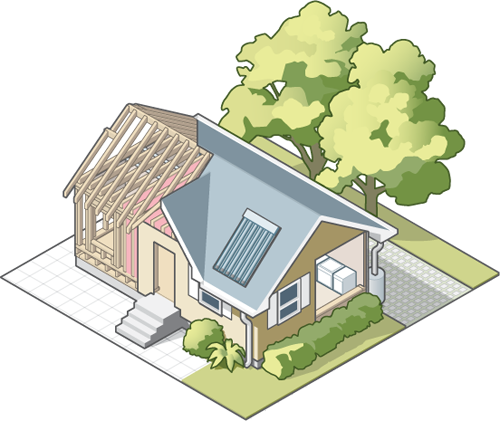
Indoor Air Quality
The key to optimizing indoor air quality (IAQ) is to identify the sources of potential contaminants and to then take the appropriate steps to minimize their impact. Common contaminants include the following:
Radon is an odorless, colorless, radioactive gas that can cause negative health effects, including lung cancer. In certain regions, elevated radon levels are naturally present in soils and can enter a house through cracks in the foundation. When building in these regions, construct appropriate radon mitigation and exhaust systems under the foundation or within the crawl space.
Moisture Excessive interior moisture is one of a home’s worst enemies, inviting pests, dust mites, rot, and mold. Excessive moisture has become a greater problem in our homes as they are sealed increasingly tighter, which results in them more prone to harboring interior moisture. There are three main causes of excessive moisture
Building Materials and Furnishings One of the major contributors to poor indoor air quality are building materials, including wood products, paints, adhesives, etc., used during construction or renovation. Choose products carefully to minimize the introduction of pollutants including (but not limited to) volatile organic compounds (VOCs), formaldehyde, lead, asbestos, fiberglass, allergens, and microorganisms. Paints, sealants, adhesives, cabinets, insulation and office machines all potentially off-gas VOCs, though low- and no- VOC products are readily available (see Paint fact sheet). Offgassing of formaldehyde, found in the binder of many wood products, can be minimized by using materials with formaldehyde- free binders or sealing all six sides of the materials with a low-permeance sealer or paint (see Cabinets fact sheet).
Pests An integrated pest management (IPM) plan will help to ensure quick identification of pest problems and that the least toxic method of treatment is used to address them. Preventative measures include pest-resistant building materials and physical pest controls such as termite barriers and properly sealed penetrations. Components of an effective IPM plan are identification, monitoring, action decisions, treatment, prevention, and controls.
Carbon monoxide is created by fuel combustion in fireplaces, automobiles, stoves, water heaters, and furnaces. Tight homes and leaky ducts have also exacerbated carbon monoxide dangers to occupants by containing the gas indoors or preventing its escape. Monitor carbon monoxide with a detector similar as one would for smoke. Make sure to vent your gas stove directly to the outside. Install fireplaces, water heaters, and furnaces that are sealed and use outdoor air for combustion. Take great care to seal your garage door and the walls that connect the garage to the home, and install a garage ventilation fan. Install ducts in non- conditioned space and test them for leakage. Leaking ducts can create negative indoor pressure, a state that could reverse the flow of the vents on combustion appliances and pull exhaust into your home.
Air Ventilation and Filtration Tighter building systems have also brought many homes to the point of requiring additional mechanical ventilation to both flush pollutants outside and introduce fresh air. As exhaust fans discharge air, the home is depressurized and replacement air is drawn from the outdoors. Such air typically comes in through holes in the home such as cracks/leaks in the walls, floors, ceilings, windows, and doors, a process which results in introducing unconditioned, unfiltered, uncontrolled and possibly humid air. Replacement air may also come in through vent pipes for the furnace, water heater and fireplace, which can introduce carbon monoxide and other dangerous gases and particulates.
Pollution Prevention Leave the outside outside. Occupants track many pollutants and contaminants, such as dust, road grime, pesticides, and fertilizers, into homes on the bottom of shoes, depositing them on floors and carpets. In addition to their adverse effect on IAQ, direct physical exposure to such substances is a potential hazard for occupants, especially small children who typically have significant contact with the floor. Minimize the impacts of tracked in pollution with a sturdy welcome mat or by offering a space for visitors to take off their shoes.
Other pollutants are brought in through the air from depressurization issues or ventilation. As mentioned earlier, seal or separate the garage/home connection. Consider outside pollutants such as high traffic roadways, neighbors, trash bins, and car exhaust when locating fresh air intakes and operable windows.
More topics:


About This Project
This project was researched, designed and coded by Phil Loubere and Jordan Kennedy in Middle Tennessee State University’s School of Journalism, Visual Communication concentration.